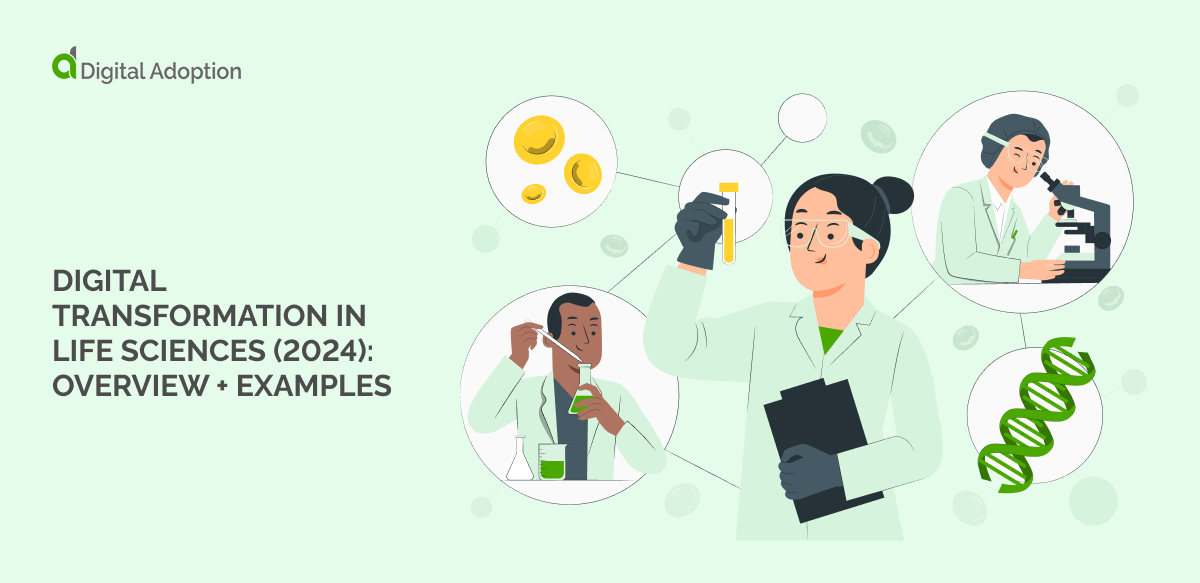RPA, AI, DAP — the world of digital innovation seems to be dominated by acronyms.
As each new acronym emerges, it’s up to CIOs and digital adoption professionals to understand what the technology means and how it can help achieve organizational goals.
This Digital Adoption Platform & Innovation playbook aims to facilitate this process by looking at some of the latest tech innovations in detail — and how they relate to the DAP.
Digital Adoption Platform & innovation: the 411
First off, the DAP: it stands for Digital Adoption Platform, a term first coined by SaaS provider WalkMe. This game-changing software was designed to help users of digital tools to navigate their features and complete tasks efficiently.
Since its creation in xx, the DAP has gone from strength to strength, absorbing and utilizing innovations in technology to improve its capability and usefulness to enterprises.
Huge strides have been made in the fields of AI and automation. And with robots tipped to replace 40% of jobs by 2030, the pace of tech innovation isn’t slowing down.
With the rise of the digital world, new challenges have arisen in terms of privacy and security — and once again, it’s up to tech innovation to keep up.
The DAP & AI
AI has changed the way we work. From workflow management tools and trend predictions to media buying, the proliferation of big data is fuelling AI and its growth.
Since AI can process vast amounts of data in an instant, issues and irregularities can be detected quickly. In today’s rapidly evolving digital world, speedy problem-detection offers enterprises a competitive advantage.
Not only that, but businesses can “train” AI to handle customer queries. This reduces the burden on support centres and reduces costs. AI is even being used in sales to identify prospects with similar buying patterns as existing customers.
AI is being used in healthcare, in banking, in virtually every industry you can think of, in fact.
As far as the Digital Adoption Platform & innovation are concerned, AI is an evolution in technology that fits with it perfectly.
The DAP uses AI — you could even say it is AI.
The hallmarks of AI are:
- Planning
- Learning
- Problem solving
- Reasoning
- Knowledge representation
- Motion
- Perception
- Manipulation
- Social intelligence
- Creativity
The DAP learns user behavior. It solves problems for users and employs reasoning to make the digital system to which it’s applied easier to use.
But the real showstopper is its ability to make predictions.
If you’re using a new CRM or other digital system, its analytics will show you how many users have recently churned. The DAP, by contrast, uses AI to predict user intentions.
The DAP can actually group users based on their likelihood to churn. It can then deploy messages and guidance to proactively keep them engaged.
This can reduce churn and poor engagement for enterprises, because users are proactively encouraged to stay and helped when they need it.
The DAP & automation
Our next Digital Adoption Platform & innovation point is about automation.
You may have heard the acronym RPA. It stands for robotic process automation and describes an emerging “intelligent automation” technology, which is based on AI.
RPA allows you to create an automated process — essentially, a robot — to operate digital systems.
There are two types of RPA: attended, which learns from the user’s actions, and unattended, which works 100% automatically and independent of the user.
Key components of this sort of intelligent automation are:
- AI / machine learning
- Natural language processing (recognizing human speech)
- Robotics (machines using the Internet of Things)
- Predictive analytics
IBM reports that intelligent automation is, changing the way enterprises operate.
“This shift – moving the burden of processes from humans to technology – has the potential to redesign the way work gets done within an enterprise.”
IBM
So, we mentioned how RPA software can operate digital systems by learning from the user. This is exactly what the DAP does. The DAP is actually a type of RPA; it learns user behavior in order to autocomplete tasks on their behalf.
“RPA is still in its early stages, but that doesn’t mean you can’t get ahead of the game and prepare for the future, today.”
WalkMe
The DAP & security
Understandably, in today’s digital world, digital decision-makers are cautious about introducing digital adoption software to their highly secure enterprise systems.
The DAP is a platform agnostic piece of software that’s overlaid to existing systems. So it’s important to go with a Digital Adoption Platform provider you trust. WalkMe is the industry gold standard, having pioneered the platform since its inception.
Meeting the most extensive compliance standards, WalkMe’s DAP uses Amazon’s top-tier secure cloud services and complies with GDPR as a data processor.
This concludes our Digital Adoption Platform & Innovation playbook. If you have any questions or comments, please feel free to leave them below!













